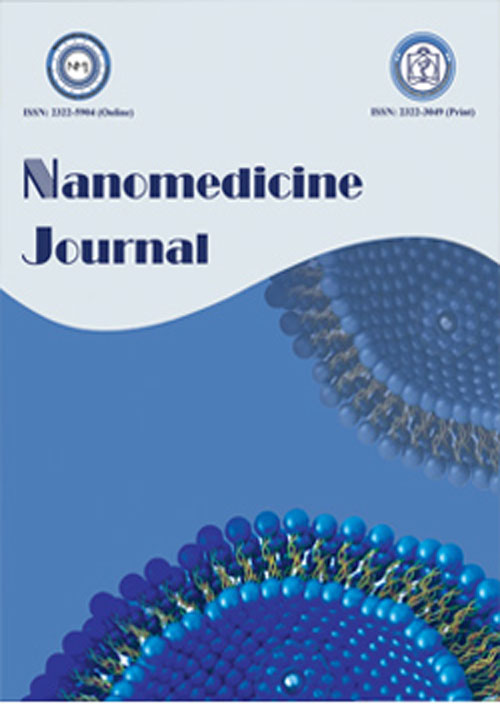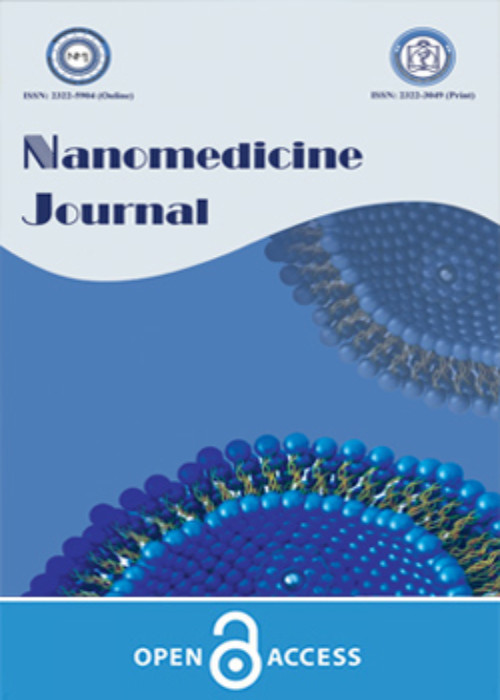فهرست مطالب

Nanomedicine Journal
Volume:8 Issue: 3, Summer 2021
- تاریخ انتشار: 1400/04/01
- تعداد عناوین: 8
-
-
Pages 156-165Exosomes, which are one of the extracellular vesicles, are considered necessary tools of intracellular communication that abundant in our body in physiological and pathological conditions with a diameter of 30-150 nm. The nanotubes, dendrimeric, metallic, nanoparticles have been used in the medical area. However, these nano-based systems are lack of standardized manufacturing methods and therefore, it has toxic effects on cells. The delivery methods of growth factors, exosomes, cells, and engineered tissues have notably advanced in the medical area. The fact that they contain bioactive molecules such as protein, lipid, RNA and DNA revealed that these structures may play an important role in the treatment of cancer. Here, we review work on the contribution exosomal mediated cancer treatment in two main topics as exogenous molecule carrier and self-use. We also emphasize the development of exosome-based systems by referring to the advantages and disadvantages of using exosomes and future perspectives in cancer therapy.Keywords: Advantages, Cancer Treatment, Cancer diagnosis, Disadvantages Exosome, Nanoparticle
-
Pages 166-178
Contrast agents (CAs) play a critical role in high-resolution magnetic resonance imaging (MRI) applications to enhance the low intrinsic sensitivity of MRI. Manganese oxide nanoparticles (MnO) have gotten developing consideration as substitute spin−lattice (T1) MRI CAs as a result of the Gd-based CAs which are related with renal fibrosis as well as the inherent dark imaging characteristics of superparamagnetic iron oxide NPs. In this review, previous developments in the usage of MnO nanoparticles as MRI CAs for cancer theranostic applications such as developments in toxicological properties, distribution and tumor microenvironment (TME)-responsive biomaterials were reviewed. A literature search was accomplished to discover distributed research that elaborates the use of MnO in multimodal imaging and therapy. In the current study, the electronic search including PubMed/Medline, Embase, ProQuest, Scopus, Cochrane and Google Scholar was performed dependent on Mesh key words. CAs can significantly improve the imaging contrast among the lesions and normal tissues. In this study we generally concentrate on typical advancements of MnO nanoparticles about properties, bimodal or multimodal imaging, and therapy. Numerous researches have demonstrated MnO-based nanostructure produce considerable biocompatibility with the lack of cytotoxicity. Therefore, remarkable features improved photothermal therapy, chemotherapy and Chemodynamic therapy.
Keywords: magnetic resonance imaging, MnO nanoparticles, Multimodal imaging, Nanomaterial -
Pages 179-186Objective(s)
Toxoplasma gondii, an obligate intracellular protozoan parasite, is widespread across the world. It causes congenital disease and abortion in humans and domestic animals. One of the major concerns in parasitology, thus, is an effective vaccine development to control Toxoplasmosis.
Materials and MethodsIn the present research, a nano-liposomal vaccine containing soluble antigens (SA) was designed to evaluate the immunity and protective efficacy against T. gondii infection in BALB/c mice. Soluble antigens (SA) were achieved from tachyzoites, encapsulated in the liposome, and investigated via scanning electron microscope. Three times with 2-week intervals, BALB/c mice were immunized subcutaneously with different formulations. The level of protection against infection was assessed through the percent survival survey of BALB/c mice after challenge with tachyzoites of T. gondii RH strain; also, the type of generated immune response was determined by evaluating the generation of cytokine (IFN-γ, IL-4) and titration of IgG isotypes.
ResultsThe immunization with liposome DSPC+ SA and liposome DSPC+ Imiquimod + SA induced a substantial increase in anti-Toxoplasma IgG antibody as compared to the PBS group (p <0.05). The IgG2a and IFN-γ secretion highest levels were seen with liposome DSPC+ Imiquimod + SA more than the control group (p <0.01) and (p <0.0001), respectively. After challenge with tachyzoites, less mortality was detected in the immunized mice by liposome DSPC + Imiquimod + SA that was meaningfully different (p <0.01) in comparison to other groups.
ConclusionVaccination with liposome DSPC + Imiquimod + SA showed more survival rate and cellular immune reaction against T. gondii.
Keywords: Cationic Liposome, Imiquimod, Immune response, Toxoplasma gondii -
Pages 187-199Objective(s)Quercetin antioxidant properties could play an important role in various fields of health. However, its use has been limited because of several disadvantages such as very low solubility in water and high instability in the presence of air, light and heat. Encapsulation of quercetin in nanostructure systems such as liposome may lead to decrease the adverse effects and protect this molecule against degradation. The aim of this study was preparation and in-vitro and in-vivo evaluation of liposomes for topical delivery of quercetin to improve the pressure ulcers.Materials and MethodsLiposomal formulations were prepared by fusion method and characterized. The amount of drug retained in and penetrated through mouse skin after 8 hours were determined. Also microscopic and macroscopic examination of laboratory animals was performed.ResultsEncapsulation efficacy of liposomes was in range 64.66-77.83%. Formulation F4 showed maximum drug release in 8 hours and the remaining drug in the skin layers was more than 46%. Histological investigation suggested that F4 and phenytoin 1% cream have the healing effect on the pressure ulcer during 28 day-treatment.ConclusionQuercetin liposomes due to its natural structure and minimal systemic absorption and side effects can be a suitable candidate for the treatment of pressure ulcers.Keywords: Fusion, Liposome, Pressure Ulcer, Quercetin, Topical delivery
-
Pages 200-210Objective(s)
Paclitaxel (PTX) and docetaxel (DTX) belong to the family of taxanes drugs which have been employed for treatment of ovarian, breast, lung, head, neck, gastric, pancreatic, bladder, prostate and cervical cancer. Controlled drug release systems improve the effectiveness of drug therapy by modifying the release profile, biodistribution, stability and solubility, bioavailability of drugs and minimize the side effects of anticancer drugs. So, the purpose of the present study was to synthesize the modified nanocomposite for the controlled releases of these drugs.
Materials and MethodsMagnetic magnesium iron oxide nanoparticles were synthesized via the co-precipitation chemical method and then composited with graphene oxide and modified by polyvinyl alcohol. The physicochemical characterization of the prepared nanocomposites was investigated by scanning electron microscope (SEM), X-ray powder diffraction (XRD) , Fourier-transform infrared spectroscopy and vibrating-sample magnetometer.
ResultsSpecific characteristics such as adsorption capacity, monodispersity, stability and hydrophilicity of magnetic nanomaterials were studied in the controlled release of anticancer drugs. Drug loading content and drug loading efficiency and release rate of drugs were investigated in vitro at different pH with ultraviolet-visible spectroscopy (UV-Vis). DLE and DLC of PTX and DTX in the modified magnetic nanocomposites were calculated as 85.2 ± 2.7% and 7.74 ± 0.24% , 89.4 ± 1.2% and 8.12 ± 0.11% of, respectively. The cumulative release amount of PTX and DTX from magnetic modified nanocomposites at pHs 5.8, 7.4 over 100 h were 58 % and 40 % and 54 % and 37 %, respectively.
ConclusionThe potential of modified nanocomposite in drug delivery systems from the intrinsic properties of the magnetic core combined with their drug loading capability and the biomedical properties of modified nanocomposite generated by different surface coatings. The generally sustained and controlled release profile of DTX (or PTX) facilitates the application of modified nanocomposite for the delivery of anticancer drugs.
Keywords: Anticancer drugs, Controlled drug release, Docetaxel, Graphene oxide, Magnetic magnesium iron nanoparticles, Polyvinyl alcohol, Paclitaxel -
Pages 211-219Objective(s)Cadmium sulfur (CdS) is a type of quantum dot which is a unique light-emitting semiconductor nanocrystal. Quantum dots have wide applications in optoelectronics, solar cells, biology, and medicine fields.Materials and MethodsMorphological properties and structural analysis for CdS were tested by using different methods (TEM, XPS and XRD). Cortical neuron cells were used for toxicity investigations. The cells were treated with different concentrations of CdS (100, 10, 1, 0.1, 0.01 µg/mL) and incubated for 24 h (5% CO2; 37°C). In vitro studies were done by examining cellular viability (MTT assay) and oxidative stress/status (TAC/TOS).ResultsAccording to our results, the increasing concentration of CdS resulted in decreased cell viability. Total antioxidant capacity (TAC) of neurons increased following exposure to the lowest concentrations of CdS. In addition, inverse to our TAC findings, total oxidant status (TOS) was decreased following exposure to lower concentrations of CdS.ConclusionRecently, because of advances in diagnostic and drug delivery systems ingestion rate of CdS by humans were increased. Hence, this study aimed to investigate the toxic effects of CdS on Cortex Neurons cell cultures. The production of CdS quantum dot particles was done by using the Viridibacillus arenosi K64 (biosynthesis method) which provides environmentally friendly, economical, reliable, and controlled production.Keywords: CdS, Cortex Neurons, TEM, XRD, XPS
-
Pages 220-228Objective(s)In this paper, we evaluated some imaging properties of Fe3O4@Au and Fe3O4@Bi hybrid nanocomposites as contrast agents in spectral CT. For this purpose, we simulated a spectral CT scanner with photon-counting detectors (PCDs) in 6 energy bins by a Monte Carlo simulator.Materials and MethodsA cylindrical phantom was designed with a diameter of 8 cm and a height of 10 cm. Fe3O4@Au and Fe3O4@Bi hybrid nanocomposites were designed as a core-shell with a diameter of 80 nm. Simulation results were utilized to reconstruct cross-sectional images through the filtered back-projection (FBP) algorithm in MATLAB software. Signal intensity and contrast to noise ratio (CNR) of tested contrast agents were calculated in spectral CT images.ResultsThe results indicated a comparable image quality for Fe3O4@Au and Fe3O4@Bi hybrid nanocomposites at different energy bins. However, in the energy range of 80 to 120 keV (bin 4 and 5), the difference in signal intensity and CNR between these two nanocomposites increased. The maximum signal intensity and CNR for Fe3O4@Au and Fe3O4@Bi were acquired at the highest concentration. The maximum signal intensity for Fe3O4@Au was 144±10 (HU) in the 4th energy bin and for Fe3O4@Bi 162±19 (HU) in the 5th energy bin. Besides, the maximum CNRs of 74±6 and 67.5±9 for Fe3O4@Au in bin 4, while for Fe3O4@Bi in bin 5 were obtained respectively.ConclusionBased on our results, Fe3O4@Au and Fe3O4@Bi hybrid nanocomposites have provided promising results as contrast agents in spectral CT. Fe3O4@Bi nanocomposites are recommended due to their lower price and availability.Keywords: bismuth nanoparticles, Gold Nanoparticles, Hybrid nanocomposites, Iron oxide nanoparticles, Spectral computed tomography
-
Pages 229-233Objective(s)Tacrolimus (TAC) is used in autoimmune diseases, organ transplantation, and nephrotic syndrome treatment. Therapeutic drug monitoring (TDM) of TAC is critical since it has narrow therapeutic index. Thus, the development of an easy and sensitive method is critical for detecting TAC in blood samples.Materials and MethodsIn this study, we aimed to design a fast, simple,and specific colorimetric sensor based on aptamer/AuNPs to detect. Initially, the aptamer was adsorbed on the surface of the gold nanoparticles (AuNPs).ResultsThen, it was expected that when the aptamer bound to TAC, AuNPs were aggregated by salt, and the color changed from red to blue. However, in our study, color did not change, and NaCl could not aggregate the AuNPs. In this approach, the optical properties of AuNPs and high affinity of aptamer were used for the detection of TAC.ConclusionHowever, according to our data, this colorimetric aptasensor was not appropriate for the detection of TAC.Keywords: Aptamer, Gold Nanoparticles, Sensor, Tacrolimus


